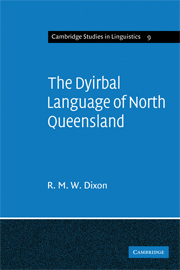Book contents
- Frontmatter
- Contents
- List of maps and plates
- Acknowledgements
- Preface
- Abbreviations and conventions
- 1 AUSTRALIAN LANGUAGES
- 2 DYIRBAL: THE LANGUAGE AND ITS SPEAKERS
- 3 WORD CLASSES
- 4 SYNTAX
- 5 DEEP SYNTAX
- 6 MORPHOLOGY
- 7 PHONOLOGY
- 8 SEMANTICS
- 9 LEXICON
- 10 PREHISTORY
- APPENDIX A DYIRBAL LOGIC
- APPENDIX B PREVIOUS WORK ON DYIRBAL
- TEXTS
- VOCABULARY
- LIST OF DYIRBAL AFFIXES
- REFERENCES
- INDEX OF AUSTRALIAN LANGUAGES
- Plate section
- Frontmatter
- Contents
- List of maps and plates
- Acknowledgements
- Preface
- Abbreviations and conventions
- 1 AUSTRALIAN LANGUAGES
- 2 DYIRBAL: THE LANGUAGE AND ITS SPEAKERS
- 3 WORD CLASSES
- 4 SYNTAX
- 5 DEEP SYNTAX
- 6 MORPHOLOGY
- 7 PHONOLOGY
- 8 SEMANTICS
- 9 LEXICON
- 10 PREHISTORY
- APPENDIX A DYIRBAL LOGIC
- APPENDIX B PREVIOUS WORK ON DYIRBAL
- TEXTS
- VOCABULARY
- LIST OF DYIRBAL AFFIXES
- REFERENCES
- INDEX OF AUSTRALIAN LANGUAGES
- Plate section
Summary
Each Dyirbal sentence has both a grammatical and a phonological description. The phonological description consists of a number of ‘phonological words’: each of these is based on a single ‘word class’ root, the phonological form of the root undergoing phonological addition or alteration corresponding to (optional) stem-forming or derivational processes and (obligatory) inflectional processes.
The word as a phonological unit is marked by an initial stressed syllable, final inflectional ending, and a fixed form: that is, the ‘constituents’ of a word cannot be permuted within the word. There is, however, considerable freedom of the order in which words can appear in a sentence (7.8).
Each word is a sequence of phonological segments, a segment being a set (or ‘bundle’) of phonological features; each feature belongs to a phonological system. A single statement of possible word structures can be given (covering words of all grammatical types). The possible phonic realisations of each phonological feature are described (relative TO the realisations of the other features in the system).
Dyirbal words tend to be phonologically rather compact: that is, certain phonological processes of insertion, assimilation, elision and conflation act to ensure that, say, a consonant cluster is not only one of the ‘possible’ clusters for the language, but is also one of the more frequent or ‘popular’ clusters (7.5). There is no phonological cohesion (sandhi and so on) between words.
- Type
- Chapter
- Information
- The Dyirbal Language of North Queensland , pp. 269 - 291Publisher: Cambridge University PressPrint publication year: 1972

